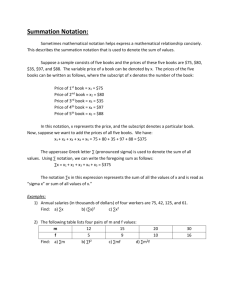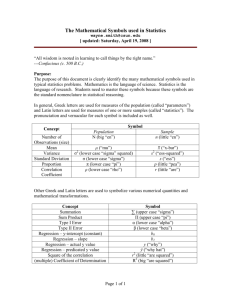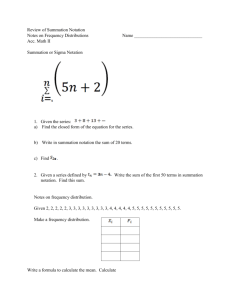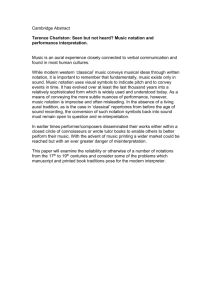Deciphering Math Notation Goals: Describe some basics of
advertisement
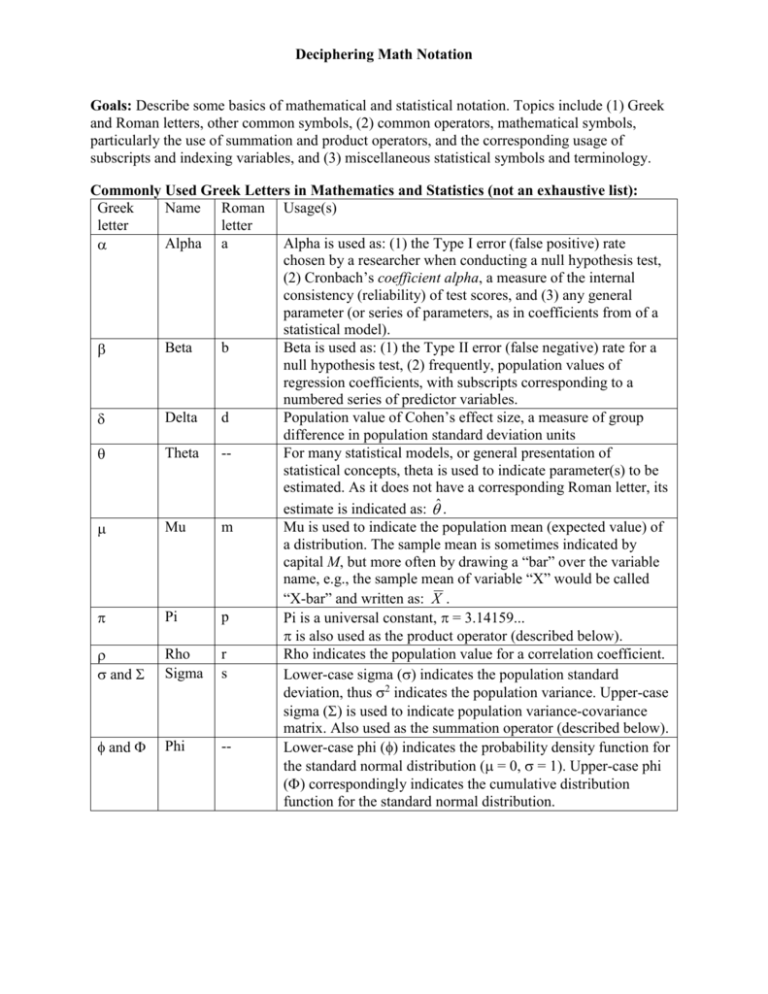
Deciphering Math Notation
Goals: Describe some basics of mathematical and statistical notation. Topics include (1) Greek
and Roman letters, other common symbols, (2) common operators, mathematical symbols,
particularly the use of summation and product operators, and the corresponding usage of
subscripts and indexing variables, and (3) miscellaneous statistical symbols and terminology.
Commonly Used Greek Letters in Mathematics and Statistics (not an exhaustive list):
Greek
Name Roman Usage(s)
letter
letter
Alpha a
Alpha is used as: (1) the Type I error (false positive) rate
chosen by a researcher when conducting a null hypothesis test,
(2) Cronbach’s coefficient alpha, a measure of the internal
consistency (reliability) of test scores, and (3) any general
parameter (or series of parameters, as in coefficients from of a
statistical model).
Beta
b
Beta is used as: (1) the Type II error (false negative) rate for a
null hypothesis test, (2) frequently, population values of
regression coefficients, with subscripts corresponding to a
numbered series of predictor variables.
Delta
d
Population value of Cohen’s effect size, a measure of group
difference in population standard deviation units
Theta -For many statistical models, or general presentation of
statistical concepts, theta is used to indicate parameter(s) to be
estimated. As it does not have a corresponding Roman letter, its
estimate is indicated as: ˆ .
Mu
m
Mu is used to indicate the population mean (expected value) of
a distribution. The sample mean is sometimes indicated by
capital M, but more often by drawing a “bar” over the variable
name, e.g., the sample mean of variable “X” would be called
“X-bar” and written as: X .
Pi
p
Pi is a universal constant, = 3.14159...
is also used as the product operator (described below).
Rho
r
Rho indicates the population value for a correlation coefficient.
and Sigma s
Lower-case sigma () indicates the population standard
deviation, thus 2 indicates the population variance. Upper-case
sigma () is used to indicate population variance-covariance
matrix. Also used as the summation operator (described below).
- and Phi
Lower-case phi () indicates the probability density function for
the standard normal distribution ( = 0, = 1). Upper-case phi
() correspondingly indicates the cumulative distribution
function for the standard normal distribution.
Deciphering Math Notation
Expressing Mathematical Relationships
Symbol
Meaning
=
Equals, equal to
Not equal to
≡
Equivalent to or Defined as
Approximately equal
or
>
Greater than
≥
Greater than or equal to
<
Less than
≤
Less than or equal to
Proportional to
Mathematical Operators and Symbols
Symbol
Meaning
+
Addition
–
Subtraction
× or * or ·
Multiplication
/ or ÷
Division
±
Plus or minus
∞
xn
Infinity
Exponentiation,
“x to the nth power”
Square root
x
n
x
exp(x) or ex
ln(x) or log(x)
…
f () or f (·)
Notes, Examples
2+2=4
x y
xy
x y or x y
6>3
x≥y
3<6
y≤x
x yn
Notes, Examples
2+2=4
1+2+3=6
5–2=3
2 – 5 = -3
2×3=6
5 * 6 = 30
3 · 4 = 12
5/2 = 2.5
3 ÷ 4 = 0.75
Often used to express a range of uncertainty
around an estimate, e.g., x = 6 ± 2 implies
that x probably lies between 4 and 8.
0<x< ∞
23 = 2 × 2 × 2 = 8
42 = 4 × 4 = 16
16 4 because 42 = 16
8 2 because 23 = 8
Radical,
“the nth root of x”
3
Exponential function,
“e to the power of x”
Natural logarithm, inverse of
the exponential function
Continuation of a series
Function
Summation,
addition of a series
e is a “universal constant,” e = 2.71828…
Product,
multiplication of a series
ln(ex) = x, and exp(ln(x)) = x
i = 1, 2, …, N
y = f (x), “y is a function of x”
N
X
i 1
i
N
X
i 1
i
X 1 X 2 ... X N
X 1 X 2 ... X N
Deciphering Math Notation
A Few Common Symbols from Set Theory (further discussed in Probability):
Symbol
Meaning
{}
Delimiter for a discrete set
()
Delimiter for an open set
[]
Delimiter for a closed set
For all, for every member, for each
Set Union
Set Intersection
Set Membership
Not a member of a set
Proper subset
Subset
